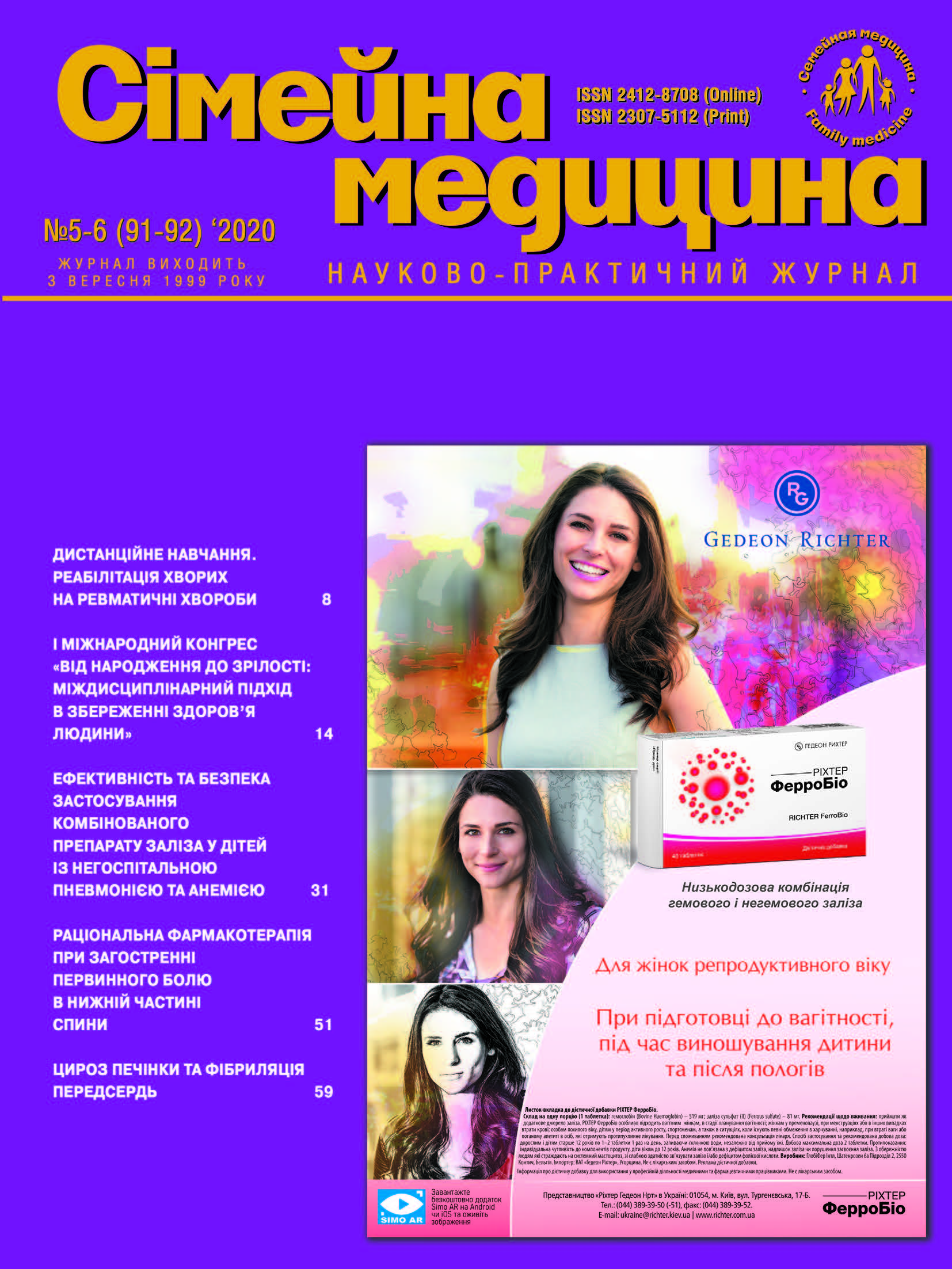The Efficacy and Safety of Using a Combined Iron Supplement in Children with Community-acquired Pneumonia and Anemia
##plugins.themes.bootstrap3.article.main##
Abstract
The article summarizes the own data and presents a scientific review of the medical literature devoted to the analysis of the problem of treatment of community-acquired pneumonia associated with anemia in children.
The objective: to optimize the treatment of community-acquired pneumonia associated with anemia in children.
Materials and methods. There were examined 100 children (53 girls and 47 boys) aged 9–17 years (the average age was 12.96 ± 0.07 years), who were treated for community-acquired pneumonia in the children’s clinical hospital No. 5 in Kiev. Children were divided into two groups: Group I – 70 patients with community-acquired pneumonia and normal levels of hemoglobin and erythrocytes; Group II – 30 children with pneumonia and anemia of the I – II stages.
Results. During the study of the localization of the pathological process in the lungs, it was found that in children of group II compared with group I, bilateral lung damage was more common (33.3 % compared to 12.9 %; p <0.05). The main indicators of peripheral blood in patients with community-acquired pneumonia and anemia were lower than in patients with community-acquired pneumonia. The clinical picture of community-acquired pneumonia with anemia and also there was analyzed the possibility of using a combined preparation of ferrous iron, manganese and copper for treatment.
Conclusion. It was found that in patients with community-acquired pneumonia and anemia, compared with patients with community-acquired pneumonia, there is a more widespread and severe inflammatory process in the lungs with prominent signs of intoxication. However, when using a medication of ferrous iron with trace elements, an improvement in indicators and the course of the disease is observed.
##plugins.themes.bootstrap3.article.details##

This work is licensed under a Creative Commons Attribution 4.0 International License.
Authors retain the copyright and grant the journal the first publication of original scientific articles under the Creative Commons Attribution 4.0 International License, which allows others to distribute work with acknowledgment of authorship and first publication in this journal.
References
Бугланов А.А., Тураев А.Т. (2002). Профилактика и лечение железодефицитных состояний мультиэлементарным препаратом Тотема. Неврология. 2: 36–36.
Будневский А.В., Есауленко И.Є., Овсянников Е.С. (2016). Анемический синдром у больных внебольничной пневмонией. Клиническая медицина. 94(1): 56–61.
Марушко Ю.В., Гищак Т.В., Хомич О.В. (2015). Особливості добового моніторингу артеріального тиску та вміст заліза у дітей з артеріальною гіпотензією. Збірник наукових праць співробітників НМАПО ім. П. Л. Шупика. 24(3): 308–313.
Марушко Ю.В., Гищак Т.В., Хомич О.В. (2020). Эффективность и безопасность применения комбинированного препарата железа у детей с железодефицитными состояниями (Обзор литературы, собственные исследования). Семейная медицина. 3: 34–38.
Наказ Міністерства охорони здоров’я України 02.11.2015 № 709.
Никитин Е.Н., Красноперова О.В., Никитин Ю.Е. (2009). Опыт лечения железодефицитной анемии препаратом феррофольгамма. Клиническая медицина. 3: 64–67.
Никитин Е.Н., Красноперова О.В., Никитин Ю.Е. (2008). Эритропоэтин у больных железодефицитной анемией. Вопросы гематологии / онкологии и иммунопатологии в педиатрии. 7(3): 5–8.
Семенова Е.Н., Кунина М.Ю., Стулков Н.І. (2013). Роль меди и марганца в метаболизме железа. Врач. 12: 47–52.
Стуклов Н.И. (2012). Мета-анализ данных переносимости питьевой формы глюконата железа (II), меди и марганца (препарат Тотема) при лечении железодефицитной анемии у детей и взрослых. Земский врач. 4(15):11–20.
Чучалин А.Г. Затяжная пневмония. (2014). Пульмонология. 3: 5–10.
Barson W., Waltham MA. (2018). Pneumonia in children: Epidemiology, pathogenesis, and etiology. UpToDate. 16: 356–360.
Bradley JS, Byington CL, Shah SS, Alverson B, Carter ER, Harrison C, et al. (2011). Executive summary: The management of community-acquired pneumonia in infants and children older than 3 months of age: Clinical practice guidelines by the Pediatric Infectious Diseases Society and the Infectious Diseases Society of America. Clin Infect Dis. 53(7): 617–30.
Bryce J, Boschi-Pinto C, Shibuya K, Black RE. (2005). WHO Child Health Epidemiology Reference Group. WHO estimates of the causes of death in children. Lancet. 365(9465): 1147–52.
Chin A. (2018). Copper Deficiency Anemia and Neutropenia Due to Ketogenic Diet. Pediatrics. 5:141–145.
Jain S, Williams DJ, Arnold SR, Ampofo K, Bramley AM, Reed C, et al. (2015). Community-acquired pneumonia requiring hospitalization among U.S. children. N Engl J Med. 372(9): 835–45.
Jomova K, Valko M. (2011). Importance of iron chelation in free radical-induced oxidative stress and human disease. Curr Pharm Des. 17 (31): 3460–3473.
Pavord S., Myers B., Robinson S. (2012). UK guidelines on the management of iron deficiency in pregnancy British Committee for Standards in Haematology. Br. J. Haematol. 156(5): 588–600.
Qin Q, Shen KL. (2015). Community-acquired pneumonia and its complications. Indian J Pediatr. 82(8): 745–51.
Rashad MM, Fayed SM, El-Hag AK. (2015). Iron-deficiency anemia as a risk factor for pneumonia in children. Benha Med J. 32: 96–100.
Santiago P. (2012). Ferrous versus Ferric Oral Iron Formulations for the Treatment of Iron Deficiency. The Scientific World Journal. 2: 20–25.
Sliql WI. (2013). Severe community-acquired pneumonia. Crit. Care Clin. 3: 563–601.
Woodhead M. (2011). Guidelines for the management of adult lower respiratory tract infections – full version. Clin. Microbiol. Infect. 6: 1–59.





